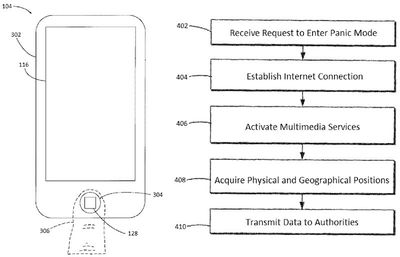The United States Patent and Trademark Office today published a patent application initially filed by Apple in May of 2014, describing a method for users to designate a specific finger to unlock an iPhone with using Touch ID, which would then cause the iPhone to enter a "panic mode" (via Business Insider). The mode could then tell the iPhone to completely lock down, limiting access to personal data if a user is being forced to unlock their iPhone.
Currently, Apple allows users to enter up to five different fingerprints to unlock an iPhone, so users would just have to designate which is the "emergency" print in the Touch ID settings menu. Apple's patent describes a situation in which a thief attempts to rob someone's iPhone from them to gain access to their personal and private data stored within, and the user being robbed quickly placing the panic mode finger on Touch ID so the thief can't access any data.

The company is going one step further with the patent application, however, describing a way in which the activation of panic mode turns on the iPhone's camera and microphone to capture a robbery or crime as it happens and sending all the data to both a user's iCloud account and possibly even local police. Another section of the patent details a possible way for the device in panic mode to act as a beacon, alerting nearby devices (other iPhones, computers, etc) to a possible crime in their vicinity so they can alert the authorities and come to the panic mode activator's aid.
In some embodiments, the mobile device 104 may be activated into the panic mode in emergency situations to act as a beacon. If there is a nearby device, the nearby other device (e.g., a PDA carried by another person, a computer in an automobile, etc.) can be alerted with an alarm so that the user of the other device might come to the aid of the user initiating the panic mode.
For example, triggering the panic mode can send out a signal on multiple frequencies, channels, links, etc., to provide location information relative to other devices so that users of the other devices can provide assistance. Furthermore, as discussed in more detail below, the panic mode may include a locator function that uses, for example, global positioning systems (GPS) and/or cellular location systems to provide the location of the mobile device 104 to emergency response providers.
The new patent -- inventor credit going to Karthik Sudhir -- also describes more basic functions of the feature, including a straight-forward klaxon that blares until a user confirms that they're safe and even a way for Touch ID users to set up specific apps to open immediately when they unlock the iPhone with specific fingers. As with all other patents, "panic mode" is far from confirmed and may never even make it into a future version of the iPhone, but it remains an interesting glimpse into the internal discussions at Apple regarding the company's possible future products.
























Top Rated Comments
I remember when I was a kid I told my mother about my bike's u-lock and she said, "What if someone just breaks the lock?" I was talking to another person about locking a car and he said, "What if someone smashes the window?" Later, when I was talking to someone about having a password on the computer, he said, "What if someone just guesses the password?"
Well, the same thing that happens when the earth explodes and destroys everything -- the feature would not work.
But what if someone doesn't break the lock? What if someone doesn't smash the window? What if someone doesn't guess the password?
What if the person faints before he could activate this feature? What if the other guy grabs the phone before you can activate this feature?
But what if Apple doesn't put in this feature at all? What if you don't use a bike lock? What if you don't lock your car? What if you don't set a password?
What if the battery doesn't die?
What if a meteor falls to the ground just as you need to activate it, and a shred of space rock flies by and cuts the tip of that particular finger you need?!
1) Disable the power switch so thief / would be thief cannot power off the device until battery dies.
2) lock SIM tray, so thief / would be thief cannot disconnect the device's communication to the cellular network, allowing greater possibility of recovery.
It's pretty much giving the law "the finger."